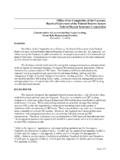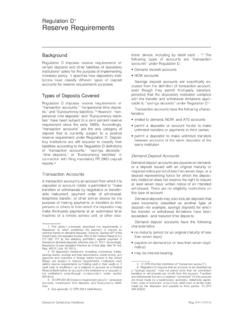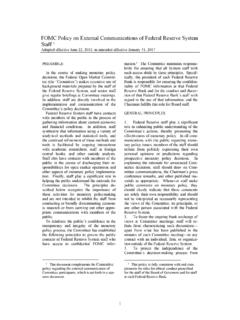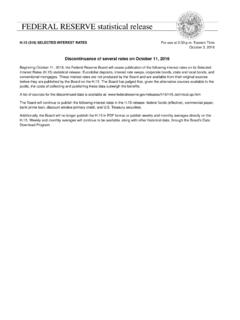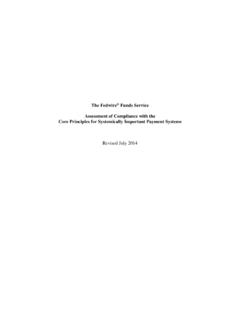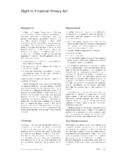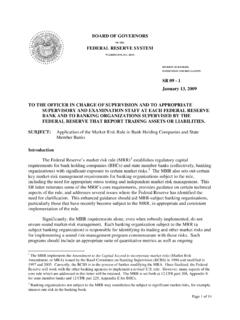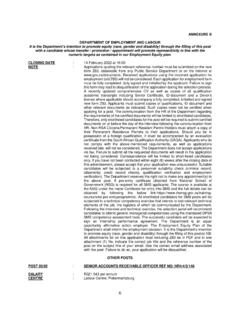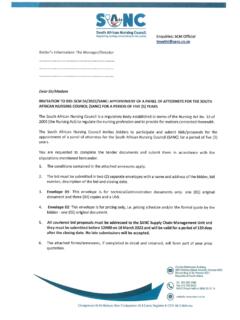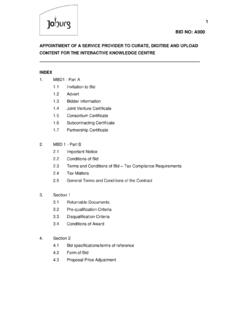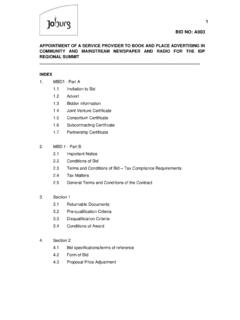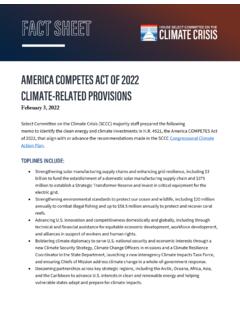Transcription of Monetary olicy rePort
1 Board of Governors of the Federal Reserve SystemFor use at 11:00 ESTF ebruary 25, 2022 Monetary Policy rePortFebruary 25, 2022 Letter of transmittaLBoard of Governors of the Federal Reserve SystemWashington, , February 25, 2022 The President of the Senate The Speaker of the House of RepresentativesThe Board of Governors is pleased to submit its Monetary Policy rePort pursuant to section 2B of the Federal Reserve ,Jerome H. Powell, ChairmanStatement on Longer-run goaLS and Monetary PoLicy StrategyAdopted effective January 24, 2012; as reaffirmed effective January 25, 2022 The Federal Open Market Committee (FOMC) is firmly committed to fulfilling its statutory mandate from the Congress of promoting maximum employment, stable prices, and moderate long-term interest rates.
2 The Committee seeks to explain its Monetary policy decisions to the public as clearly as possible. Such clarity facilitates well-informed decisionmaking by households and businesses, reduces economic and financial uncertainty, increases the effectiveness of Monetary policy, and enhances transparency and accountability, which are essential in a democratic , inflation, and long-term interest rates fluctuate over time in response to economic and financial disturbances. Monetary policy plays an important role in stabilizing the economy in response to these disturbances. The Committee s primary means of adjusting the stance of Monetary policy is through changes in the target range for the federal funds rate.
3 The Committee judges that the level of the federal funds rate consistent with maximum employment and price stability over the longer run has declined relative to its historical average. Therefore, the federal funds rate is likely to be constrained by its effective lower bound more frequently than in the past. Owing in part to the proximity of interest rates to the effective lower bound, the Committee judges that downward risks to employment and inflation have increased. The Committee is prepared to use its full range of tools to achieve its maximum employment and price stability maximum level of employment is a broad-based and inclusive goal that is not directly measurable and changes over time owing largely to nonmonetary factors that affect the structure and dynamics of the labor market.
4 Consequently, it would not be appropriate to specify a fixed goal for employment; rather, the Committee s policy decisions must be informed by assessments of the shortfalls of employment from its maximum level, recognizing that such assessments are necessarily uncertain and subject to revision. The Committee considers a wide range of indicators in making these inflation rate over the longer run is primarily determined by Monetary policy, and hence the Committee has the ability to specify a longer-run goal for inflation. The Committee reaffirms its judgment that inflation at the rate of 2 percent, as measured by the annual change in the price index for personal consumption expenditures, is most consistent over the longer run with the Federal Reserve s statutory mandate.
5 The Committee judges that longer-term inflation expectations that are well anchored at 2 percent foster price stability and moderate long-term interest rates and enhance the Committee s ability to promote maximum employment in the face of significant economic disturbances. In order to anchor longer-term inflation expectations at this level, the Committee seeks to achieve inflation that averages 2 percent over time, and therefore judges that, following periods when inflation has been running persistently below 2 percent, appropriate Monetary policy will likely aim to achieve inflation moderately above 2 percent for some policy actions tend to influence economic activity, employment, and prices with a lag.
6 In setting Monetary policy, the Committee seeks over time to mitigate shortfalls of employment from the Committee s assessment of its maximum level and deviations of inflation from its longer-run goal. Moreover, sustainably achieving maximum employment and price stability depends on a stable financial system. Therefore, the Committee s policy decisions reflect its longer-run goals, its medium-term outlook, and its assessments of the balance of risks, including risks to the financial system that could impede the attainment of the Committee s Committee s employment and inflation objectives are generally complementary.
7 However, under circumstances in which the Committee judges that the objectives are not complementary, it takes into account the employment shortfalls and inflation deviations and the potentially different time horizons over which employment and inflation are projected to return to levels judged consistent with its Committee intends to review these principles and to make adjustments as appropriate at its annual organizational meeting each January, and to undertake roughly every 5 years a thorough public review of its Monetary policy strategy, tools, and communication : T his rePort reflects information that was publicly available as of noon EST on February 23, 2022 (the one exception is the GDP data published on February 24, 2022).
8 Unless otherwise stated, the time series in the figures extend through, for daily data, February 22, 2022; for monthly data, January 2022; and, for quarterly data, 2021:Q4. In bar charts, except as noted, the change for a given period is measured to its final quarter from the final quarter of the preceding figures 23 and 35, note that the S&P/Case-Shiller National Home Price Index, the S&P 500 Index, and the Dow Jones Bank Index are products of S&P Dow Jones Indices LLC and/or its affiliates and have been licensed for use by the Board. Copyright 2022 S&P Dow Jones Indices LLC, a division of S&P Global, and/or its affiliates.
9 All rights reserved. Redistribution, reproduction, and/or photocopying in whole or in part are prohibited without written permission of S&P Dow Jones Indices LLC. For more information on any of S&P Dow Jones Indices LLC s indices, please visit S&P is a registered trademark of Standard & Poor s Financial Services LLC, and Dow Jones is a registered trademark of Dow Jones Trademark Holdings LLC. Neither S&P Dow Jones Indices LLC, Dow Jones Trademark Holdings LLC, their affiliates, nor their third-party licensors make any representation or warranty, express or implied, as to the ability of any index to accurately represent the asset class or market sector that it purports to represent, and neither S&P Dow Jones Indices LLC, Dow Jones Trademark Holdings LLC, their affiliates, nor their third-party licensors shall have any liability for any errors, omissions, or interruptions of any index or the data included.
10 1 Recent Economic and Financial Developments .. 1 Monetary Policy .. 2 Special Topics .. 3 Part 1: Recent Economic and Financial Developments ..5 Domestic Developments.. 5 Financial Developments .. 31 International Developments .. 36 Part 2: Monetary Policy ..41 Part 3: Summary of Economic Projections ..47 Abbreviations ..65 List of BoxesThe Limited Recovery of Labor supply .. 8 Differences in Wage and Employment Growth across Jobs and Workers .. 11 How Widespread Has the Rise in Inflation Been? .. 15 supply chain Bottlenecks in Manufacturing and Trade .. 19 Developments Related to Financial Stability.
